

A Belleville Guide
Multicultural Belleville is Paris' most appetising neighbourhood
Words and images by Sofia Levin
Last updated 27.05.2024
If Paris’ culinary worth is judged on flavour and diversity instead of Michelin Stars, then Belleville is its most appetising neighbourhood.
Belleville may be sandwiched between the 10th, 11th, 19th and 20th arrondissements, but the cuisines of this Paris neighbourhood spread across continents, from Africa to Asia. A lap around the block will take you past kosher butchers with banh mi-shop neighbours and green grocers selling “tous produits exotiques” (all exotic products) to Caribbean and African locals. In amongst it all, bourgeois-bohèmes – known colloquially as “bobos” – swirl natural wine at the bar of gentrification.
This smorgasbord of society is layered with culture, courtesy of the migrant communities that have coexisted here for decades. Poles, Greeks and Armenians settled locally before the Second World War, followed later by sephardic Africans from Tunisia and Nigeria. In the 1970s, Chinese and Vietnamese communities also moved in. But Belleville has forever been a place to eat, drink and be merry.








Before it became part of Paris in 1860, it was a village with farms, orchards and vineyards. Belleville was outside Paris’ taxable area, which made it a cheaper location to drink and celebrate than within the capital. When Baron Haussmann demolished Paris’ slums as part of his radical urban redevelopment (1853 to 1871), hundreds of thousands of displaced and disadvantaged people moved to Paris’ east, where they were united as supporters of the Paris Commune. The joie de vivre of the working class was far from extinguished; they gathered in cabarets, theatres and guinguettes, a tavern named after cheap, young guinguette wine that was frequently consumed here.
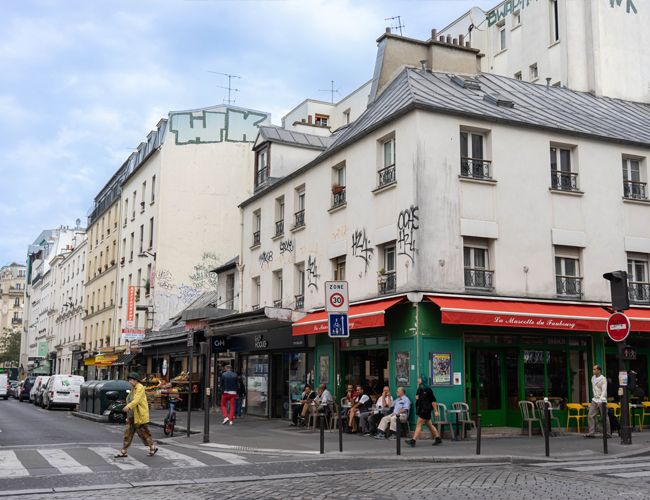


Today, Belleville is a world away from Paris’ wide, Haussmannian boulevards and sparkling storefronts – though only 15 minutes from the centre via Metro. Belleville’s grittiness tends to be positively reframed as a personality trait by its bobo crowd and visitors, but privilege is what allows those passing through to overlook the litter that decorates the curbs more abundantly than street art, disadvantaged huddles drinking in Parc de Belleville during the day, and the West African youths who seek refuge there at night. It's something to keep in mind as you explore the quartier, better known among tourists as the home of Père-Lachaise Cemetery, but too often overlooked as a dining destination.
Chinoise (Chinese)
Belleville is home to Paris’ second Quartier Chinois (Chinatown), which emerged during the 1980s and is centred around Boulevard de Belleville in the 20th arrondissement. Le Cheval d'Or was one of the earlier restaurants to open in 1987, a little further up the hill. It still has the original modest red shopfront embellished with a golden horse, but a slick, young team has been at the reigns since 2023. The French-Chinese bistro menu is a favourite among chefs. Dishes might include poached cod quenelles wrapped in fried tofu and splashed with nantua sauce (which has a creamy crayfish base), or ricotta-filled tortellini with the fermented funk of doubanjiang bean paste, a la mapo tofu.

There’s a glut of delicious, more low-fi Chinese restaurants near the Belleville Metro station, centred around the major intersection of Boulevard de Belleville and Rue de Belleville. Along the latter, people crowd into Restaurant Chez Alex Wenzhou, which heats pork brioches (buns) on the spot to take away for less than a couple of euros. Ravioli Nord Est specialises in affordable dumplings (“raviolis” in French) and cold appetisers, like shredded potato and kelp salad.
Noodles are hand-pulled in the window at La Tour de Belleville, ready to be submerged into heady pork and beef broths bobbing with tender brisket, while Chez Trois is your best bet for fragrant, northern Chinese dishes, such as cumin and chilli lamb brochette (skewers) from Xinjiang. For a Chinese breakfast, make a beeline for Best Tofu and dunk youtiao (doughnut sticks) into either sweet or savoury tofu pudding. Le Grand Bol serves more substantial dishes, whether garlicky pork ribs, glistening duck, slippery razor clams or other decadent seafood.


Asie du Sud-Est (Southeast Asian)
Within the Chinatown precinct are some Southeast Asian gems. At Ama Siam on Rue de Belleville, the second generation of neighbouring Thai and Laotian restaurant, Lao Siam, recreates the dishes of their childhood using local ingredients. Lao Siam opened in 1985 and continues to serve traditional Thai cuisine, such as hor mok pla steamed fish custard, fragrant sai oua sausage and yam woo sen glass noodle salad. They also host collaborative pop-ups with local food businesses.
At Ama Sam, tradition continues in a more modern setting, with krathong rice-flour pastry shells filled with minced pork and veggies, fried whole sea bream in yam sauce with green mango, and moo pralo (braised five-spied pork belly with soft boiled egg and pickles). Viet Passion is the neighbourhood pick for Vietnamese cuisine. Banh mi are available here, but chả giò (Vietnamese rice spring rolls) and bún bò huế (spicy beef noodle soup) are house specialties.
Africaine (African)
Tunisian cafes and restaurants are scattered throughout Belleville, waking locals up with steaming clay bowls of lablabi chickpea stew and shakshuka, and assembling casse croute Tunisien from morning through to after midnight (a sandwich on doughnut-like bread, often ordered with tuna, sliced olive, boiled egg and smoky, piquant harissa). Lablabi chez Mokhtar is a small, bright blue shop with minimal seating where you’ll eat with the local Tunisian community. Some Tunisian restaurants also make for ideal late-night dining in Paris, including Kool Food, Di-Napoli and Restaurant Les Délices de Tunisie, all open until 2am most nights. Chez Rene et Gabin is another popular, all-day spot serving homely, cafeteria-style Tunisian food to a handful of sheltered tables on the footpath. They do a roaring local takeaway trade thanks to their daily specials, whether fish couscous on a Wednesday, Thursday's mloukhia (simmered jute leaf soup/stew) or Friday's t'fina aricha, a beef stew commonly eaten on Shabbat.

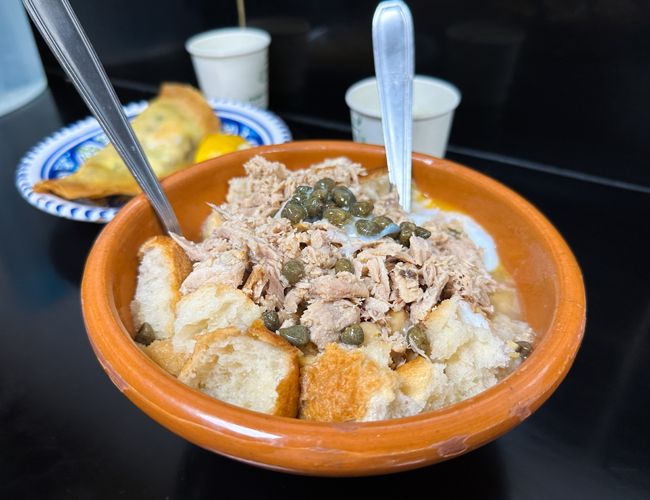
Algeria has another roll worth knowing: the merguez (North African lamb sausage). You’ll find an oversized version down a side street off Boulevard de Belleville at Marco’s Grill, a store run by Jewish Algerians. There’s also foie, kefta and steak available, and you can order any of them as a generous plate with salad and roughly cut potato chips instead of in bread. Hang around to gesture to staff that you would like all of the condiments slopped on top, then sit in the window or at one of the outdoors tables on the pedestrian street and watch Belleville go by.


Autour du Monde (Around the World)
Although there is heavy culinary representation in Belleville from Asia and Africa, it doesn’t stop there. At Le Mezze Du Chef, the focus is çig köfte; little fistfuls of meat-free steak tartare from Turkey's southeast. The dish is based on a classic street food made from minced lean beef, kneaded together with bulghur and spices, but it’s harder to find these days due to health and safety regulations. The more common vegetarian version, made with peppers, is available in this unassuming corner of Paris, served with a pile of pickles and a wedge of iceberg lettuce.
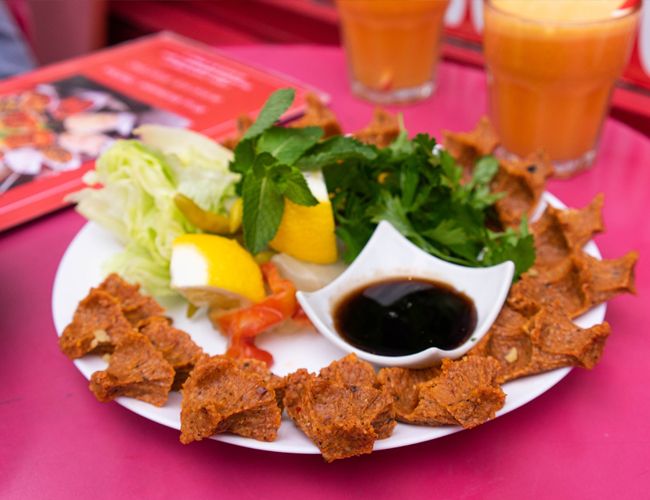

L' Artisan Libanais is a Lebanese cafe and mini grocer near Pyrénées station, open from lunch through to after dinner. Faux-bougainvillea carpets the ceiling, with decorative wooden panelling and traditional black-and-white tiles continuing the theme. Pita wraps with fillings ranging from kofta to foie de volaille (chicken liver) can be ordered to takeaway or dine-in, while the glass counter tempts with mounds of dips, salads and sambousek.
Specialites Antillaises Menilmontant is a dedicated Caribbean caterer, grocer and delicatessen that’s been serving the community since 1960. It’s a righteous pre-picnic spot where you can load up on French-Creole specialties such as chicken fricassee, sausage stew, fried fish and slow-cooked legumes. The back of the store is further stocked with traditional Caribbean pastries prepared on site. Cakes and flaky pies here are filled with exotic fruits like guava, coconut and pineapple.



Bistrots Français (French Bistros)
It would be remiss not to mention at least a couple of classic French bistros. Besides, Belleville's best also happen to be some of Paris' best. First up, Quedubon is unpretentious French perfection. The wine-focussed bistro has wooden floors gently textured by time and friendly staff who know the ins and outs of every bottle adorning the shelves. An entrée, main and dessert is €24, selected from a daily blackboard menu brought to the table. To start, perhaps a velvety chilled pumpkin soup or beef tongue pastrami, sliced to order. For mains, it could be grilled mackerel with pickled cucumber, blanquette de veau (veal stew) or duck breast with bell peppers. Wild game and offal are the pride of the house, particularly cervelle de veau; creamy veal brain gently poached in lemon butter and pan seared until every crevasse has a caramelised crust.


Le Baratin is another top choice in the city for real Parisienne dining. It seems to grace every list suggesting “where to eat in Paris” thanks largely to its rustic blackboard menu. Think white asparagus submitted into velouté or momentarily blanched and served with lard and parmesan; turbot in broth form with ginger, and its flesh alongside seasonal vegetables buttered in the pan; or hearty plates like yielding beef cheek and confit veal. While the food and poky room are warm and cosy, the service, famously, is not. If you consider this all part of the experience, book ahead as Le Baratin is consistently packed.

Restaurants Sympas (roughly, “What's Hot”)
While eating through layers of history and culture is always exciting, Belleville also has a reputation across Paris for a la mode venues, to borrow from the language. Le Grand Bain is one of the stayers. Behind its industrial, steel facade is a warm, French bistro that has been getting it right since 2017. Most of the space is dedicated to a curved wooden island bar, the best spot for a glass of natural wine and plates made for sharing that you might not want to share. The blackboard might promise peppers paired with sweetbreads or layered across a tarte tatin; pork partnered with dried fig in terrine, or its belly with raisins, smoked mashed potato and watercress.


The Le Grand Bain team also owns the boulangerie across the road called Le Petit Grain, where kouign-amanns are crusted with sesame seeds, cinnamon is spiralled through brioche and all loaves and pastries are made with natural leavenings. The empire continues on the corner with Le Café des Delices. It was revived in early 2023, but prior to that the terracotta-tiled cafe was an institution among the Jewish Tunisian community, where men would gather to gossip, play cards and drink coffee. Open from morning until after midnight, breakfast is simple, while later bites might include ‘nduja croquettes, a fish burger or lamb shaved over flatbread.

If your perfect feed consists of a couple of glasses of wine accompanied by a hunk of soft cheese, a plate obscured in swathes of cured meat and pimped-up seasonal vegetables, Buttes Snack Bar near the entrance of Parc des Buttes-Chaumont is for you. Although one could easily eat a dinner’s worth of mussels with black rice, chargrilled octopus and duck macaroni, Buttes Snack Bar is the perfect spot for eating in between or after meals.
You can also pair Buttes with Soces, an ecallier (seafood restaurant) with former Clamato chef Marius de Ponfilly in the kitchen. Up at the bar is a selection of shellfish on ice: gooseneck barnacles, whelks, clams, oysters and crab. Settle in for the full menu and, depending on the time of year, you could be in for dishes such as cuttlefish bouillabaisse and fish rillettes with fermented gooseberry.
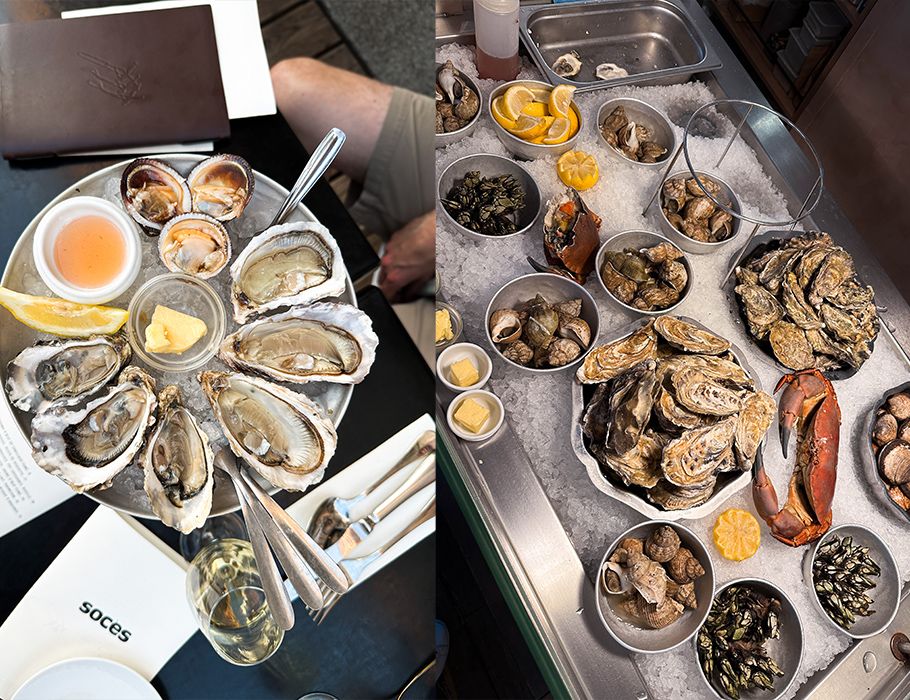
To cram in as much of Belleville as possible, you could plan to progressively snack at some of the aforementioned wine bars and bistros, organised around a main booking somewhere unique, like Dame Jane. If it weren’t for the tables, you’d be forgiven for thinking you’d walked into someone’s home. Here, owner Julie Caute hosts residencies that see different chefs and sommeliers take over her space every fortnight. Bookings are essential and upcoming chefs are shared via social media.
It would be remiss not to mention Paloma, one of Paris’ “it” restaurants. People who “know food” will recommend it to you, as they did to me. It was slammed when I visited mid-week without a booking and landed a seat at 10pm. The wine list leans minimal intervention, and the blackboard menu touts French bistro classics with a sprinkle of Japanese flavour. The atmosphere is undeniably cool; Paloma has the same air as wine bars serving seasonal dishes in cities like Melbourne and London. On this particular occasion, the food didn’t live up to the hype: a take on roasted tête de veau (calf's head) with borlotti beans and kalamata olive was dry, and the whelks not properly purged of their slime. You can pass your own judgment, but perhaps a visit during the day for Paloma’s €16 three-course lunch is less risky if food is what's most important to you.
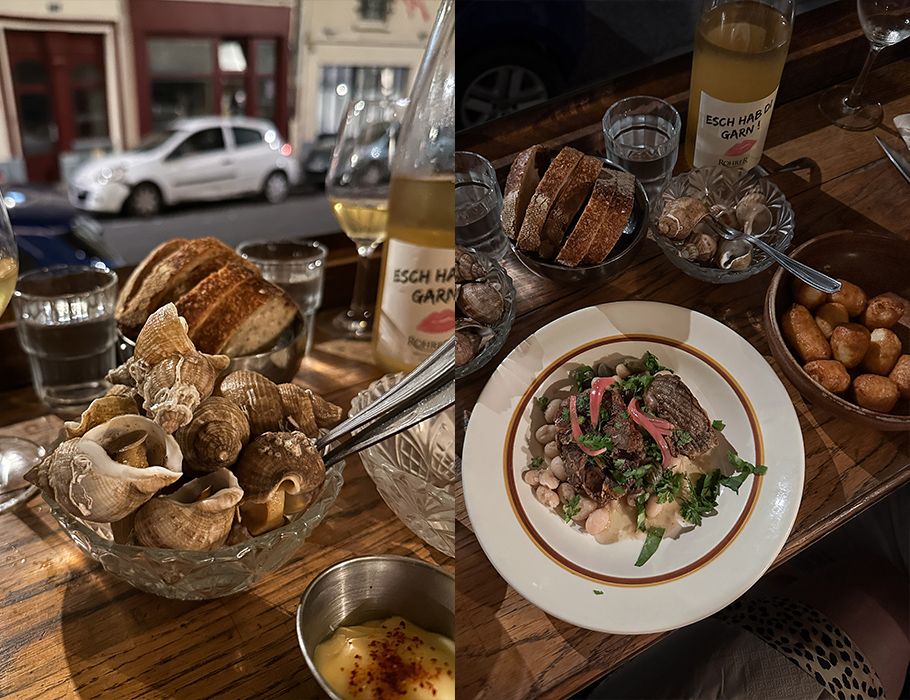
Less than 10 minutes away on foot from Paloma is Bang Bang, a small and playful eatery on Rue du Liban. The concept is simple: chilli to the front. Bang Bang’s sunglasses-wearing, moustache-sporting chilli mascot and blue-and-yellow colour scheme are signs that fun trumps authenticity here, with the mash-up menu consisting of spicy dishes borrowed from around the world. It reads almost like AI wrote it: barbecued beef with green sambal and lemongrass relish, smoked ricotta dolma red curry, dry ramen with 'nduja and fried shallots. Good, spicy fun designed for eaters who don’t take themselves too seriously.
Boire (To Drink)
Although a small vineyard in Parc de Belleville is all that remains of the area’s viticultural roots, the neighbourhood has always been home to local watering holes. As listed above, there are lots of wine bars in the area that double as restaurants and bistros, but for one that’s a little different, try Supra, a Georgian “cave” across the road from Le Baratin. Wines here are imported straight from the Motherland, with lots of exciting orange and lesser-known varieties to try. Pick a bottle from the shelf and enjoy for a small corkage fee, and be sure to order some Georgian specialties off the menu: perhaps khachapuri boat-shaped bread stuffed with cheese, sulguni (sour, smoky cow’s milk cheese), khinkali dumplings or pkhali eggplant rolls.

A gentrified crowd brings a modern thirst, and Belleville is no stranger to a decent cocktail. The area’s most lauded bar is Combat, an airy, women-owned cocktail haunt that’s recognised as a World’s 50 Best Discovery. There’s no snootiness here as you approach the stainless-steel bar beneath the foliage-covered ceiling, just a welcoming atmosphere, a window for serving guests outside and a seasonal cocktail menu with a focus on sustainability. Ask for the “cocktail du jour”.
Another top spot for a cocktail is Kissproof, a bar from Beirut that butts up against the small square of Place Fréhel. Don’t mistake the abundance of outdoor terrace seating for the plastic chairs and cheap drinks of adjacent bar, Culture Rapide, which attracts a younger, more backpacker-esque crowd. Both are watched over by Benjamin Vautier’s 1993 street art instillation that features two workers attempting to mount a chalkboard-like billboard that reads, “Il faut se méfier des mots” (beware of the words).

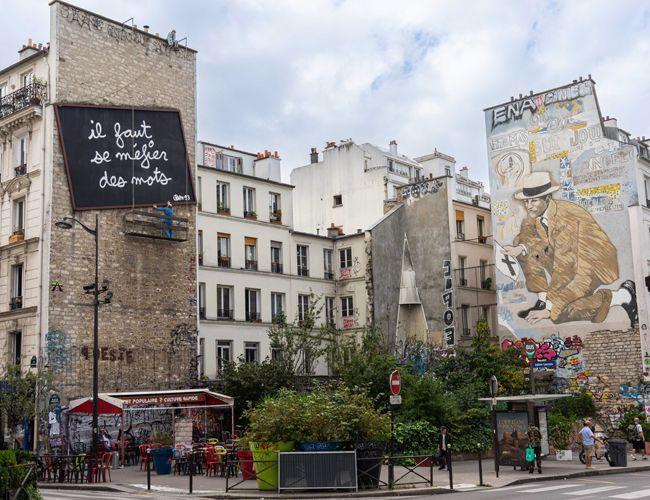
La Bellevilloise exists on a much larger scale; a cultural institution with a community heart. The enormous building was Paris’ first worker’s co-op back in the 1800s. Yes, there’s a bar, but it’s also a restaurant, club, live music venue, exhibition space and cinema with a terrace and rooftop. Check the website to decide if you want to see a gig, join a workshop, visit a market or attend a buffet brunch with a live jazz band.
If it’s atmosphere you seek, visit Aux Folies or Moncoeur, though note that both offer more in terms of atmosphere than food quality. Aux Folies is an institution. It doesn’t matter the time of day, locals sit facing the street drinking either beer or coffee; reading, working, gossiping or simply enjoying the company of their dog on a seat beside them. When it’s warm and busy, the crowd spills into the adjoining laneway where it’s not uncommon to hear buskers and peruse stalls set up by art galleries. Moncoeur has the ultimate terrace perched above Parc de Belleville. It’s not in your best interest to dine here, but you might like to soak up the sweeping views of Paris and a distant Eifel Tower come aperitif time, especially if there’s live music scheduled.

La Cave de Belleville is the place to stock up on French wine for your accommodation or picnic. There’s a focus on organic, biodynamic and natural wines from all over France. The store is also a wine bar and sells cheese and cured meat, so you can stop in for a platter and sip until you find something you like. Note that as is often the case across Europe, wine isn’t always stored in temperature-controlled conditions, so be a little wary of old bottles that might have been sitting on the shelf for some time.
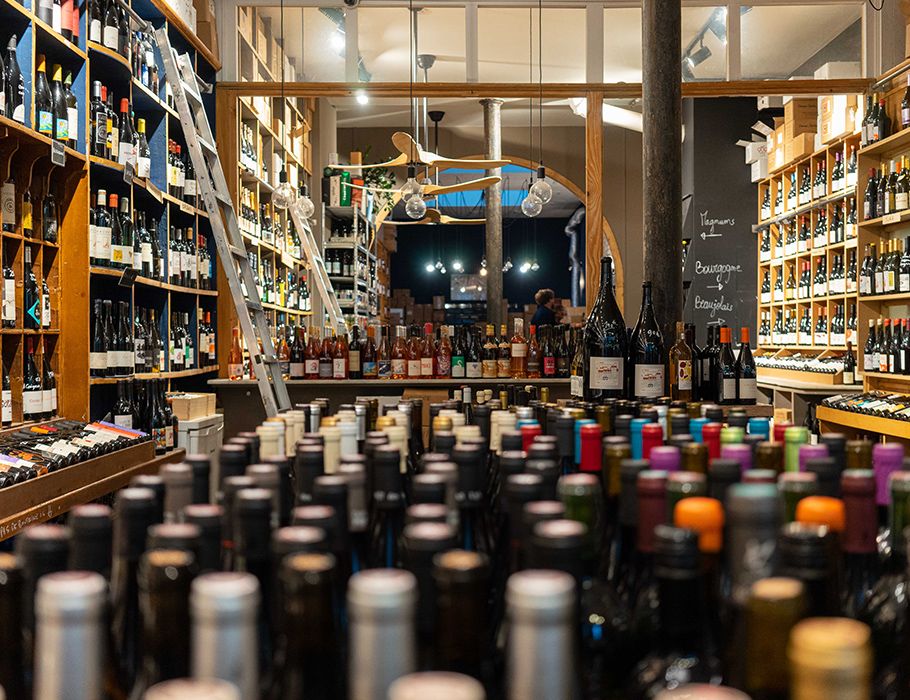
Hôtels: Où Dormir (Where to Sleep)
There are two modern, charming and affordable boutique hotels in the heart of Belleville that are perfect bases for exploring:
Babel Belleville: 31 small rooms with moody, opulent and stylish decor inspired by world travels, with design nods to Turkey and India. A decent restaurant, too. From €132 (AUD $215) per night. Book here.


Hotel Scarlett: 30 small, clean and modern rooms with pops of colour and a vibrant, youthful feel. Bonus points for the location beside Le Baratin. From €116 (AUD $190) per night. Book here.
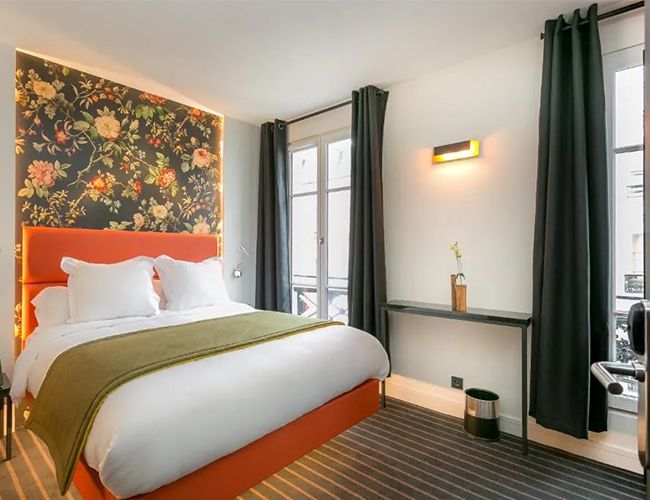

Join the Eat Curiously Movement
Subscribe to the food newsletter that goes deeper.
